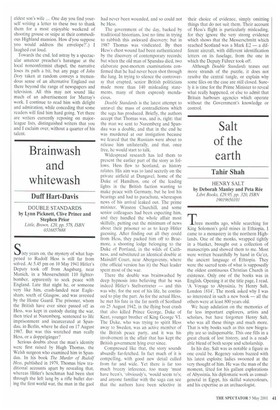Salt of the earth
Tahir Shah
HENRY SALT by Deborah Manley and Peta Ree Libri Books, £29.95, pp. 320, ISBN 19019650101 Three months ago, while searching for King Solomon's gold mines in Ethiopia, I came to a monastery in the northern Highlands. One of the monks, wrapped tightly in a blanket, brought out a collection of manuscripts and showed them to me. Most were written beautifully by hand in Ge'ez, the ancient language of Ethiopia. They were the sacred texts of what is supposedly the oldest continuous Christian Church in existence. Only one of the books was in English. Opening it at the title page, I read, 'A Voyage to Abyssinia. by Henry Salt, London 1814'. The monk asked why I was so interested in such a new book — all the others were at least 800 years old.
We heap adulation on the memories of far less important explorers, artists and scholars, but have forgotten Henry Salt, who was all these things and much more. That is why books such as this new biography are so indispensable. This one fills in a great chunk of lost history, and is a readable blend of both scope and scholarship.
In his day. Salt was as notable a figure as one could be. Regency salons buzzed with his latest exploits; ladies swooned at the very thought of him. He was the man of the moment, feted for his gallant explorations of Abyssinia, his diplomatic work as consulgeneral in Egypt, his skilful watercolours, and his expertise as an archaeologist. Salt, whose father was a tradesman, was the youngest of eight children. He was educated in the classics and sent to study painting under John Hoppner, one of the most eminent portraitists of the day. He was known as a man who would accept any level of criticism, but was given to procrastination and depression. The thing that saved him was his longing to escape.
That opportunity came in 1802, when he was employed by Viscount Valentia, as a draughtsman on a long voyage to the East. Salt caught his first glimpses of the Empire's most radiant jewels — the Cape of Good Hope, Calcutta, Bombay, Ceylon. At every port of call the reception was opulent in the extreme: caparisoned elephants and palanquins furnished with the finest silks, liveried footmen and exotic gifts.
After India, Salt was dispatched as Valentia's emissary to Massowah on the Red Sea. Tall, articulate and utterly charming, he had slipped easily from draughtsman into the role of diplomat. He and his retinue journeyed from the coast into the Abyssinian hinterland. Even today Ethiopia is a country of extraordinary hardship. My own travels there have been more exacting than any I've ever undertaken. But two centuries ago the expedition must have been the ultimate feat of endurance.
Dressed in the garb of an Abyssinian. Salt became a guest of the Emperor. He quickly developed an admiration for Abyssinia which was never to leave him. When finally he returned to London for a respite, he was nicknamed 'the Lion of Abyssinia', as he amused and amazed high society with tales of Darkest Africa.
Those expeditions provided Salt with a shrewdness in diplomacy, and the ability to remain impartial through the most acrimonious debates. In 1816, he was appointed British Consul-General to Egypt, a post he served in until his death 11 years later.
Walk through the Egyptian collections of the Louvre or the British Museum today, and much of what you see is there because of Henry Salt. While consul-general, he employed the indomitable Giovanni Belzoni to excavate Thebes and Abu Simbel, and he conducted studies of the Pyramids and the Sphinx. The result was an astonishing collection of antiquities, which included the head of Rameses II (today in the British Museum), and the fabulous alabaster sarcophagus of Seti I, which now lies in the vault of the Soane Museum, in Lincoln's Inn Fields.
When he succumbed to dysentery in Alexandria. aged 47, Salt's close circle of friends included Mehemet Ali, the founder of modern Egypt, Sir Joseph Banks, Johann Burckhardt, Caviglia and Champollion. It seems incredible that such a figure could have disappeared like this, almost without trace. So Manley and Ree's vivid and engaging biography is especially valuable. Without it, you might have had to travel to that monastery in the Ethiopian Highlands, like I did, to find Henry Salt.











































































 Previous page
Previous page